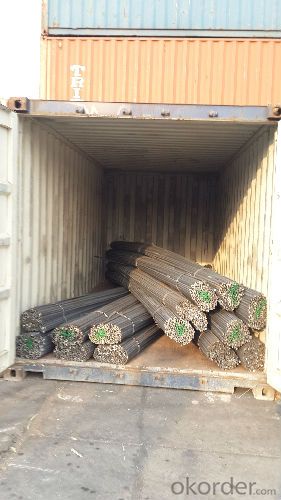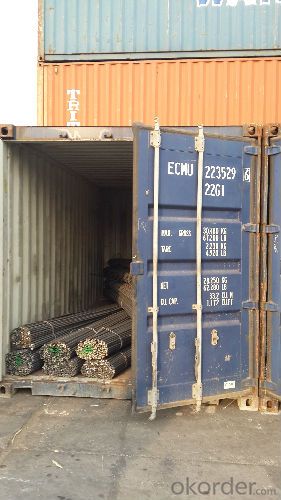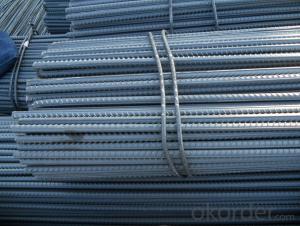Reinforcing Deformed with high quality Steel Bars
- Loading Port:
- Tianjin
- Payment Terms:
- TT or LC
- Min Order Qty:
- 50 m.t
- Supply Capability:
- 20000 m.t/month
OKorder Service Pledge
OKorder Financial Service
You Might Also Like
Product Description:
OKorder is offering Reinforcing Deformed with high quality Steel Bars Building Material China Manufacturer at great prices with worldwide shipping. Our supplier is a world-class manufacturer of steel, with our products utilized the world over. OKorder annually supplies products to European, North American and Asian markets. We provide quotations within 24 hours of receiving an inquiry and guarantee competitive prices.
Product Applications:
Reinforcing Deformed with high quality Steel BarsBuilding Material China Manufacturer are ideal for structural applications and are widely used in the construction of buildings and bridges, and the manufacturing, petrochemical, and transportation industries.
Product Advantages:
OKorder's Reinforcing Deformed with high quality Steel Bars,Building Material China Manufacturer are durable, strong, and resist corrosion.
Main Product Features:
· Mill test certification
· Professional Service
· Competitive pricing
Product Specifications:
HRB400 Deformed Steel Bar Details:
Minimum Order Quantity: | 25MT | Unit: | m.t. | Loading Port: | China Main Port |
Supply Ability: | 800000TONS/YEAR | Payment Terms: | TT or LC |
Product Description:
Specifications of HRB400 Deformed Steel Bar:
Standard | GB | HRB400 | |
Diameter | 6mm,8mm,10mm,12mm,14mm,16mm,18mm,20mm, 22mm,25mm,28mm,32mm,36mm,40mm,50mm | ||
Length | 6M, 9M,12M or as required | ||
Place of origin | Hebei, China mainland | ||
Advantages | exact size, regular package, chemical and mechanical properties are stable. | ||
Type | Hot rolled deformed steel bar | ||
Brand name | DRAGON | ||
Chemical Composition: (Please kindly find our chemistry of our material based on HRB500 as below for your information)
Grade | Technical data of the original chemical composition (%) | ||||||
C | Mn | Si | S | P | V | ||
HRB400 | ≤0.25 | ≤1.60 | ≤0.80 | ≤0.045 | ≤0.045 | 0.04-0.12 | |
Physical capability | |||||||
Yield Strength (N/cm²) | Tensile Strength (N/cm²) | Elongation (%) | |||||
≥400 | ≥570 | ≥14 | |||||
Theoretical weight and section area of each diameter as below for your information:
Diameter(mm) | Section area (mm²) | Mass(kg/m) | Weight of 12m bar(kg) |
6 | 28.27 | 0.222 | 2.664 |
8 | 50.27 | 0.395 | 4.74 |
10 | 78.54 | 0.617 | 7.404 |
12 | 113.1 | 0.888 | 10.656 |
14 | 153.9 | 1.21 | 14.52 |
16 | 201.1 | 1.58 | 18.96 |
18 | 254.5 | 2.00 | 24 |
20 | 314.2 | 2.47 | 29.64 |
22 | 380.1 | 2.98 | 35.76 |
25 | 490.9 | 3.85 | 46.2 |
28 | 615.8 | 4.83 | 57.96 |
32 | 804.2 | 6.31 | 75.72 |
36 | 1018 | 7.99 | 98.88 |
40 | 1257 | 9.87 | 118.44 |
50 | 1964 | 15.42 | 185.04 |
FAQ
Q1: How do we guarantee the quality of our products?
A1: We have established an advanced quality management system which conducts strict quality tests at every step, from raw materials to the final product. At the same time, we provide extensive follow-up service assurances as required.
Q2: How soon can we receive the product after purchase?
A2: Within three days of placing an order, we will begin production. The specific shipping date is dependent upon international and government factors, but is typically 7 to 10 workdays.
Q3: Why buy Materials & Equipment from OKorder.com?
A3: All products offered byOKorder.com are carefully selected from China's most reliable manufacturing enterprises. Through its ISO certifications, OKorder.com adheres to the highest standards and a commitment to supply chain safety and customer satisfaction.
Images:


- Q:Are steel rebars suitable for use in aggressive environments?
- Yes, steel rebars are suitable for use in aggressive environments. Steel rebars are commonly used in construction projects, including those in aggressive environments such as coastal areas, chemical plants, and wastewater treatment facilities. They possess excellent durability, strength, and corrosion resistance properties, making them highly suitable for withstanding aggressive elements like saltwater, chemicals, and moisture. Additionally, proper protective coatings can be applied to enhance their resistance to corrosion, ensuring their long-term performance in aggressive environments.
- Q:How do steel rebars improve the structural integrity of concrete?
- The structural integrity of concrete is greatly improved by steel rebars in several ways. Firstly, they bolster the tensile strength of concrete, which is otherwise feeble in tension. While concrete excels in compressive strength, it lacks the ability to withstand pulling or stretching forces. By inserting steel rebars into the concrete, the overall tensile strength of the structure is significantly heightened. The steel rebars function as reinforcement by dispersing stress and load across a wider area, preventing cracks and fractures from spreading through the concrete. They establish a sturdy bond between the concrete and the reinforcement, enabling the structure to bear heavy loads and withstand bending, shearing, and other forces that could jeopardize its stability. Furthermore, steel rebars aid in managing and mitigating the impacts of shrinkage and thermal expansion and contraction that occur in concrete. These occurrences frequently lead to cracking and structural damage. The steel rebars help restrict the movement of the concrete, lessening the likelihood of crack formation and ensuring the overall integrity of the structure. Moreover, steel rebars prolong the durability and lifespan of concrete structures. They possess a high resistance to corrosion, which is particularly crucial in environments with elevated moisture levels, chemical exposure, or contact with saltwater. The presence of steel rebars safeguards the concrete from deterioration and extends the lifespan of the structure. In conclusion, steel rebars play a vital role in enhancing the structural integrity of concrete by fortifying its tensile strength, distributing stress and loads, preventing cracks, managing shrinkage, resisting bending and shearing forces, and increasing durability. They provide a dependable and efficient reinforcement system that guarantees the stability and longevity of concrete structures.
- Q:Are steel rebars suitable for earthquake-resistant structures?
- Yes, steel rebars are suitable for earthquake-resistant structures. Steel rebars provide excellent tensile strength and reinforcement to concrete structures, making them more resistant to the lateral forces and vibrations caused by earthquakes. They help to distribute and absorb the energy generated during seismic events, enhancing the overall structural integrity and reducing the risk of collapse. Steel rebars have been widely used in earthquake-prone areas and are considered a reliable choice for ensuring the safety and stability of buildings and infrastructure during earthquakes.
- Q:How do steel rebars impact the overall constructability and scheduling of concrete projects?
- Steel rebars play a crucial role in the overall constructability and scheduling of concrete projects. These reinforcing bars are essential for providing strength and stability to concrete structures, ensuring their durability and resilience. Firstly, steel rebars enhance the constructability of concrete projects by providing reinforcement and support to the concrete. By adding rebars within the concrete, the overall structural integrity of the project is significantly improved. This reinforcement allows for the construction of taller and more complex structures, as the rebars help distribute the load and resist tension and compression forces. Moreover, steel rebars facilitate the scheduling of concrete projects. When properly planned and incorporated, rebars can expedite construction timelines. By incorporating rebars into the concrete formwork, construction teams can efficiently pour and shape the concrete, reducing the time required for curing and achieving the desired strength. This has a direct impact on project scheduling, allowing for faster construction progress and potential cost savings. Additionally, the use of steel rebars in concrete projects enables flexibility in design and construction. The ability to customize the placement, size, and spacing of rebars ensures that the concrete structure meets the specific design requirements and intended functionality. This flexibility is particularly important in projects that require intricate architectural features or specific load-bearing capacities. However, it is essential to note that the proper installation and coordination of steel rebars can pose challenges in terms of scheduling. Rebar installation must be carefully coordinated with other construction activities to avoid delays. Furthermore, quality control measures are crucial to ensure the correct placement and alignment of rebars, as any errors or deficiencies can impact the overall quality and safety of the project. In conclusion, steel rebars have a significant impact on the constructability and scheduling of concrete projects. They enhance the overall strength and stability of concrete structures, allowing for the construction of more intricate and robust designs. Additionally, the proper incorporation of rebars can expedite construction timelines and provide flexibility in project scheduling. However, careful planning, coordination, and quality control are necessary to ensure the successful integration of rebars in concrete projects.
- Q:What are the marking of the steel bars on the mills? Which factory is the 2LG16 thread?
- Each steel bar has an identification, each steel bar has a nameplate, each batch of steel bars have factory qualification certificate, and the qualification certificate is corresponding to the nameplate and the corresponding content of the identification, and has traceability.
- Q:Can steel rebars be used in structures subjected to extreme temperatures?
- Yes, steel rebars can be used in structures subjected to extreme temperatures. However, it is important to consider the specific grade and composition of the steel and the temperature range it can withstand without losing its structural integrity. Additionally, certain precautions and appropriate design considerations may be necessary to ensure the performance and durability of the steel rebars in extreme temperature conditions.
- Q:Can steel rebars be used in the construction of museums and cultural centers?
- Yes, steel rebars can be used in the construction of museums and cultural centers. Steel rebars provide strength and durability, making them suitable for reinforcing concrete structures.
- Q:What are the guidelines for inspecting and testing steel rebars on-site?
- To ensure the structural integrity and safety of a construction project, it is essential to conduct on-site inspections and tests on steel rebars. Here are some guidelines to consider: 1. Begin with a visual inspection, checking for any visible defects such as rust, cracks, or deformities. Also, ensure that the rebars' size, shape, and alignment comply with the project's specifications and standards. 2. Keep accurate documentation of the rebars, including their origin, grade, and dimensions. This information will help track compliance with the project's requirements and identify any potential issues. 3. Take representative samples from each batch of rebars for further testing. The number of samples required may vary depending on the project's specifications and regulatory requirements. 4. Verify compliance with the project's requirements by measuring the rebars' length, diameter, and shape. Ensure that they are within the permissible limits and not bent or twisted excessively. 5. Conduct a chemical composition analysis to ensure that the rebars meet the specified standards. This analysis typically involves testing for elements like carbon, sulfur, phosphorus, and manganese. 6. Determine the rebars' mechanical properties through tensile and yield strength tests. This testing helps ensure that the rebars can withstand the expected loads and stresses during construction. 7. Assess the rebars' ductility and ability to withstand bending without fracture or significant deformation through a bend test. This test is particularly important for rebars used in reinforced concrete structures. 8. Use ultrasonic testing techniques to detect any internal defects that may affect the rebars' performance. These defects, such as voids, cracks, or inclusions, may not be visible to the naked eye. 9. Evaluate the rebars' resistance to corrosion, especially in moisture or chemically exposed environments. This assessment may involve techniques such as measuring corrosion potential or analyzing chloride content. 10. Keep comprehensive records of all inspection and testing activities, including test results and any deviations from the project's specifications. This documentation acts as evidence of compliance and aids in future audits or quality control checks. It is important to note that these guidelines provide a general framework for on-site inspection and testing of steel rebars. Always refer to specific project requirements, industry standards, and local regulations for a more detailed and accurate procedure.
- Q:What are the guidelines for the proper curing of concrete with steel rebars?
- The proper curing of concrete with steel rebars requires adherence to the following guidelines: 1. Moisture: To ensure proper hydration and strength development, it is necessary to maintain moisture during the curing process. However, excessive moisture should be avoided when curing concrete with steel rebars to prevent corrosion and damage. Therefore, it is important to strike a balance between providing sufficient moisture and preventing the accumulation of standing water around the rebars. 2. Covering: During the pouring process, it is crucial to adequately cover the steel rebars with concrete to protect against corrosion. The thickness of the cover should meet the design specifications to ensure adequate strength and durability. 3. Curing time: The curing time for concrete with steel rebars is typically longer than that of plain concrete. This is due to the need for the steel to bond with the concrete and achieve proper adhesion. The recommended curing period may vary depending on factors such as ambient temperature, humidity, and the specific type of steel used. It is important to refer to the project specifications or consult with a structural engineer to determine the appropriate curing time for the specific application. 4. Temperature control: Temperature control is essential during the curing process to ensure uniform hydration and prevent thermal stress. Rapid temperature changes can lead to cracking and compromise the integrity of the concrete. Therefore, it is important to protect the concrete from extreme temperature variations and provide insulation or shading as necessary. 5. Protection from external elements: Concrete with steel rebars must be safeguarded against external elements that can cause damage or corrosion. This includes protection from chloride ions, carbonation, and chemicals. Additional protection can be provided by applying suitable surface coatings or sealants. 6. Inspection and maintenance: Regular inspection and maintenance are vital for ensuring the long-term durability of concrete with steel rebars. It is important to monitor for signs of corrosion, cracking, or deterioration and take appropriate action promptly. This may involve repairing damaged areas, applying protective coatings, or implementing measures to prevent corrosion. By following these guidelines, the proper curing of concrete with steel rebars can be achieved, resulting in a construction material that is structurally sound and durable, capable of withstanding the test of time.
- Q:What is the standard size of steel rebars?
- The standard size of steel rebars typically ranges from 6mm to 50mm in diameter.
1. Manufacturer Overview |
|
|---|---|
| Location | |
| Year Established | |
| Annual Output Value | |
| Main Markets | |
| Company Certifications | |
2. Manufacturer Certificates |
|
|---|---|
| a) Certification Name | |
| Range | |
| Reference | |
| Validity Period | |
3. Manufacturer Capability |
|
|---|---|
| a)Trade Capacity | |
| Nearest Port | |
| Export Percentage | |
| No.of Employees in Trade Department | |
| Language Spoken: | |
| b)Factory Information | |
| Factory Size: | |
| No. of Production Lines | |
| Contract Manufacturing | |
| Product Price Range | |
Send your message to us
Reinforcing Deformed with high quality Steel Bars
- Loading Port:
- Tianjin
- Payment Terms:
- TT or LC
- Min Order Qty:
- 50 m.t
- Supply Capability:
- 20000 m.t/month
OKorder Service Pledge
OKorder Financial Service
Similar products
New products
Hot products
Related keywords





























